Western Sydney University: National Male Health Policy Analysis Report
VerifiedAdded on 2022/11/14
|12
|3249
|459
Report
AI Summary
This report analyzes the National Male Health Policy of Australia, focusing on its introduction in 2010 and its aims to improve men's health outcomes. The policy addresses socioeconomic factors, work hazards, and biological and social determinants of health, aligning with WHO guidelines. The report discusses the policy's objectives, including promoting equal health outcomes, improving health at all ages, and preventing health issues. It highlights the importance of male health, the need for consultation, and capacity building. The analysis examines the policy's impact, including its influence on life expectancy and health disparities among different male demographics. The report also explores the policy's commitment to addressing health challenges faced by men and the importance of providing information and resources for men and healthcare professionals. The policy aims to engage men in their healthcare through education, healthy lifestyle adoption, and regular checkups. The document also discusses the consultations and capacity building efforts that were made before the policy's launch.
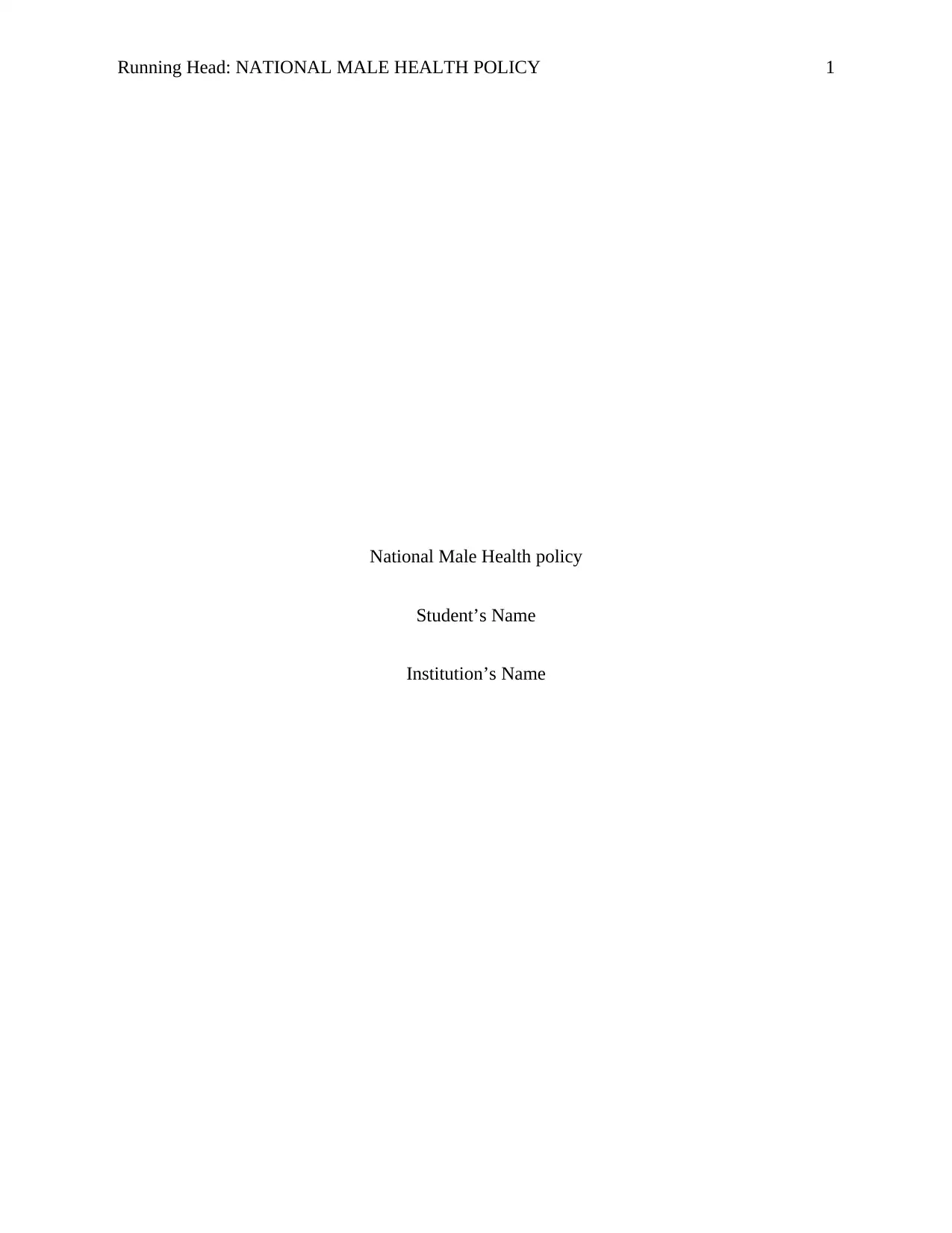
Running Head: NATIONAL MALE HEALTH POLICY 1
National Male Health policy
Student’s Name
Institution’s Name
National Male Health policy
Student’s Name
Institution’s Name
Paraphrase This Document
Need a fresh take? Get an instant paraphrase of this document with our AI Paraphraser
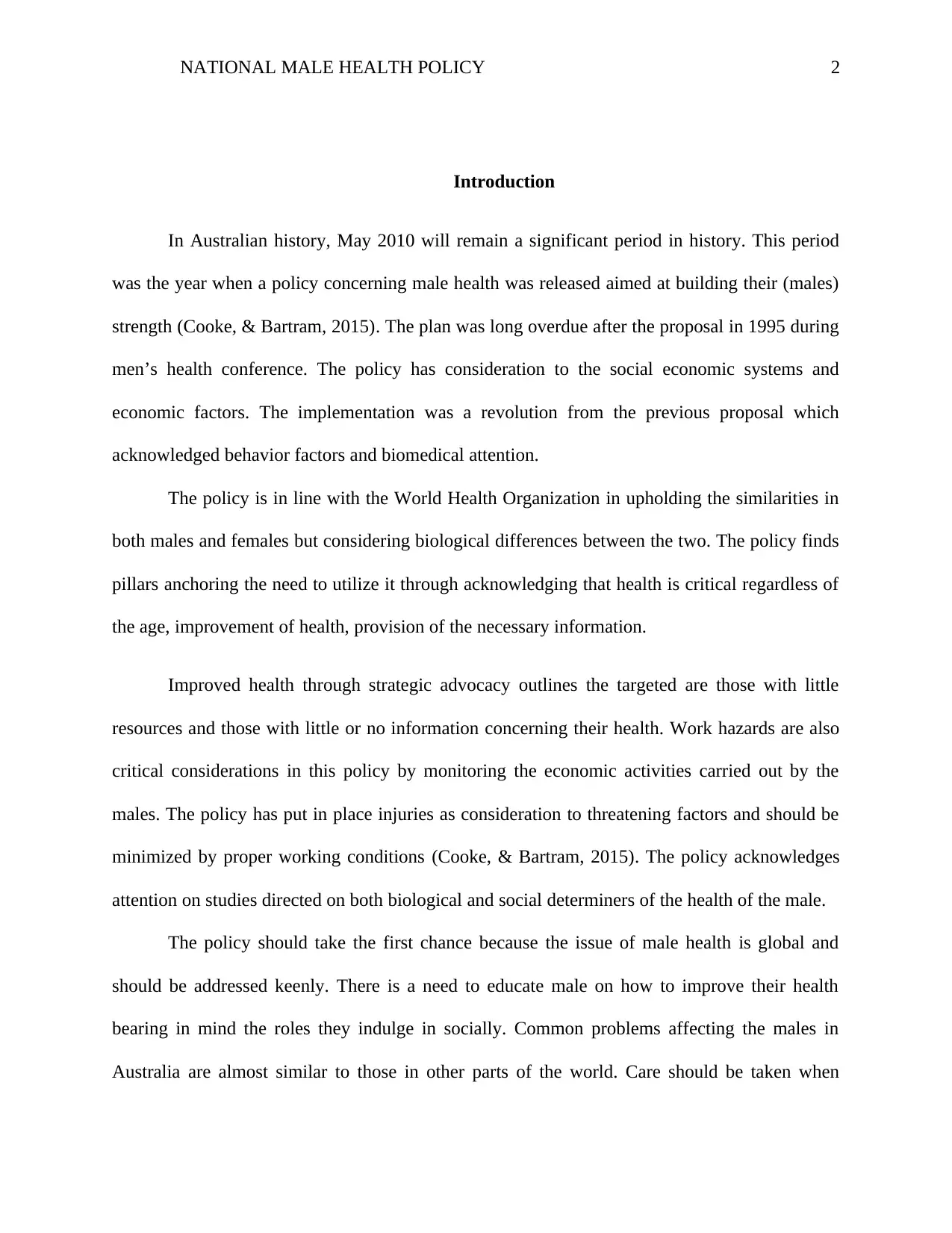
NATIONAL MALE HEALTH POLICY 2
Introduction
In Australian history, May 2010 will remain a significant period in history. This period
was the year when a policy concerning male health was released aimed at building their (males)
strength (Cooke, & Bartram, 2015). The plan was long overdue after the proposal in 1995 during
men’s health conference. The policy has consideration to the social economic systems and
economic factors. The implementation was a revolution from the previous proposal which
acknowledged behavior factors and biomedical attention.
The policy is in line with the World Health Organization in upholding the similarities in
both males and females but considering biological differences between the two. The policy finds
pillars anchoring the need to utilize it through acknowledging that health is critical regardless of
the age, improvement of health, provision of the necessary information.
Improved health through strategic advocacy outlines the targeted are those with little
resources and those with little or no information concerning their health. Work hazards are also
critical considerations in this policy by monitoring the economic activities carried out by the
males. The policy has put in place injuries as consideration to threatening factors and should be
minimized by proper working conditions (Cooke, & Bartram, 2015). The policy acknowledges
attention on studies directed on both biological and social determiners of the health of the male.
The policy should take the first chance because the issue of male health is global and
should be addressed keenly. There is a need to educate male on how to improve their health
bearing in mind the roles they indulge in socially. Common problems affecting the males in
Australia are almost similar to those in other parts of the world. Care should be taken when
Introduction
In Australian history, May 2010 will remain a significant period in history. This period
was the year when a policy concerning male health was released aimed at building their (males)
strength (Cooke, & Bartram, 2015). The plan was long overdue after the proposal in 1995 during
men’s health conference. The policy has consideration to the social economic systems and
economic factors. The implementation was a revolution from the previous proposal which
acknowledged behavior factors and biomedical attention.
The policy is in line with the World Health Organization in upholding the similarities in
both males and females but considering biological differences between the two. The policy finds
pillars anchoring the need to utilize it through acknowledging that health is critical regardless of
the age, improvement of health, provision of the necessary information.
Improved health through strategic advocacy outlines the targeted are those with little
resources and those with little or no information concerning their health. Work hazards are also
critical considerations in this policy by monitoring the economic activities carried out by the
males. The policy has put in place injuries as consideration to threatening factors and should be
minimized by proper working conditions (Cooke, & Bartram, 2015). The policy acknowledges
attention on studies directed on both biological and social determiners of the health of the male.
The policy should take the first chance because the issue of male health is global and
should be addressed keenly. There is a need to educate male on how to improve their health
bearing in mind the roles they indulge in socially. Common problems affecting the males in
Australia are almost similar to those in other parts of the world. Care should be taken when
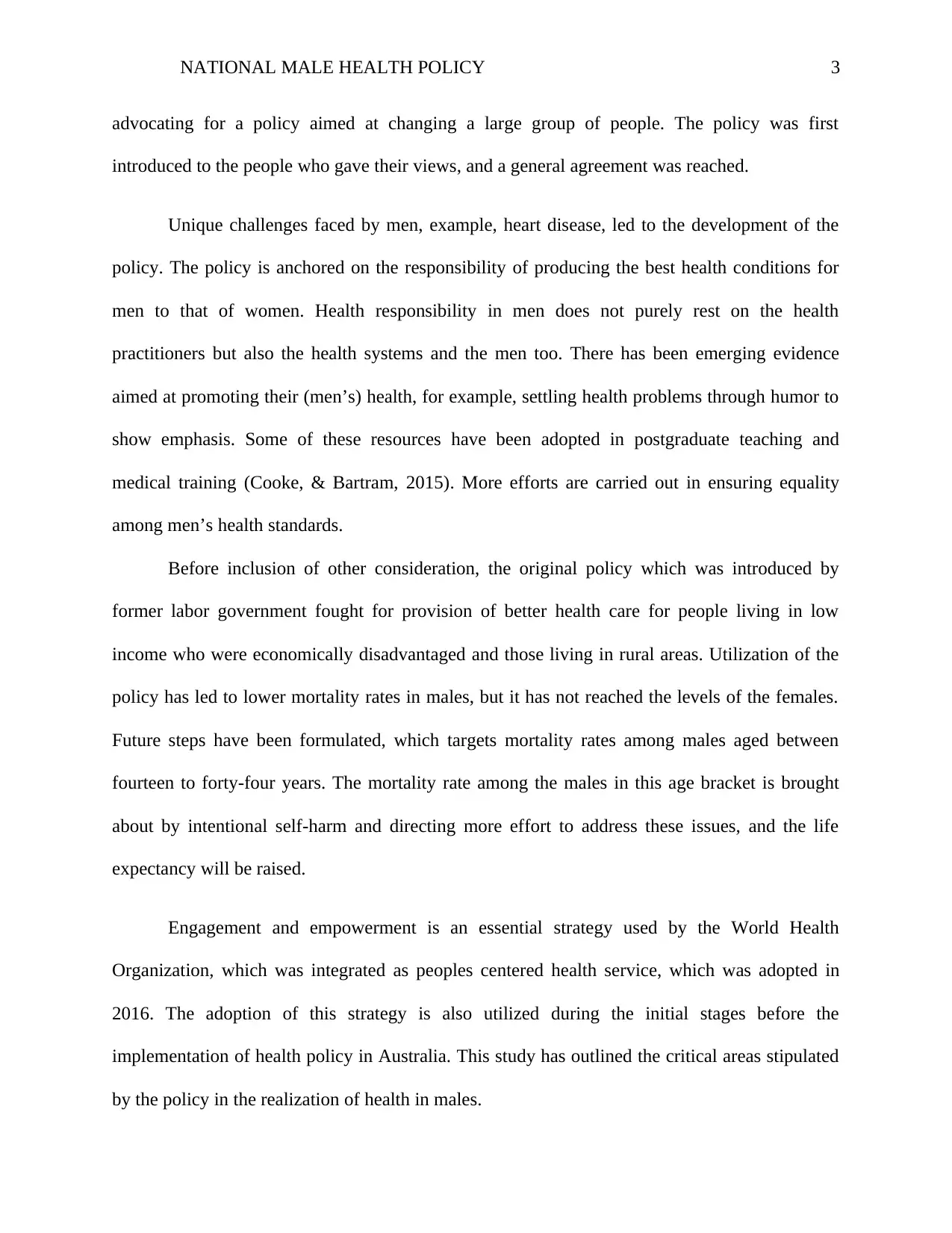
NATIONAL MALE HEALTH POLICY 3
advocating for a policy aimed at changing a large group of people. The policy was first
introduced to the people who gave their views, and a general agreement was reached.
Unique challenges faced by men, example, heart disease, led to the development of the
policy. The policy is anchored on the responsibility of producing the best health conditions for
men to that of women. Health responsibility in men does not purely rest on the health
practitioners but also the health systems and the men too. There has been emerging evidence
aimed at promoting their (men’s) health, for example, settling health problems through humor to
show emphasis. Some of these resources have been adopted in postgraduate teaching and
medical training (Cooke, & Bartram, 2015). More efforts are carried out in ensuring equality
among men’s health standards.
Before inclusion of other consideration, the original policy which was introduced by
former labor government fought for provision of better health care for people living in low
income who were economically disadvantaged and those living in rural areas. Utilization of the
policy has led to lower mortality rates in males, but it has not reached the levels of the females.
Future steps have been formulated, which targets mortality rates among males aged between
fourteen to forty-four years. The mortality rate among the males in this age bracket is brought
about by intentional self-harm and directing more effort to address these issues, and the life
expectancy will be raised.
Engagement and empowerment is an essential strategy used by the World Health
Organization, which was integrated as peoples centered health service, which was adopted in
2016. The adoption of this strategy is also utilized during the initial stages before the
implementation of health policy in Australia. This study has outlined the critical areas stipulated
by the policy in the realization of health in males.
advocating for a policy aimed at changing a large group of people. The policy was first
introduced to the people who gave their views, and a general agreement was reached.
Unique challenges faced by men, example, heart disease, led to the development of the
policy. The policy is anchored on the responsibility of producing the best health conditions for
men to that of women. Health responsibility in men does not purely rest on the health
practitioners but also the health systems and the men too. There has been emerging evidence
aimed at promoting their (men’s) health, for example, settling health problems through humor to
show emphasis. Some of these resources have been adopted in postgraduate teaching and
medical training (Cooke, & Bartram, 2015). More efforts are carried out in ensuring equality
among men’s health standards.
Before inclusion of other consideration, the original policy which was introduced by
former labor government fought for provision of better health care for people living in low
income who were economically disadvantaged and those living in rural areas. Utilization of the
policy has led to lower mortality rates in males, but it has not reached the levels of the females.
Future steps have been formulated, which targets mortality rates among males aged between
fourteen to forty-four years. The mortality rate among the males in this age bracket is brought
about by intentional self-harm and directing more effort to address these issues, and the life
expectancy will be raised.
Engagement and empowerment is an essential strategy used by the World Health
Organization, which was integrated as peoples centered health service, which was adopted in
2016. The adoption of this strategy is also utilized during the initial stages before the
implementation of health policy in Australia. This study has outlined the critical areas stipulated
by the policy in the realization of health in males.
⊘ This is a preview!⊘
Do you want full access?
Subscribe today to unlock all pages.

Trusted by 1+ million students worldwide
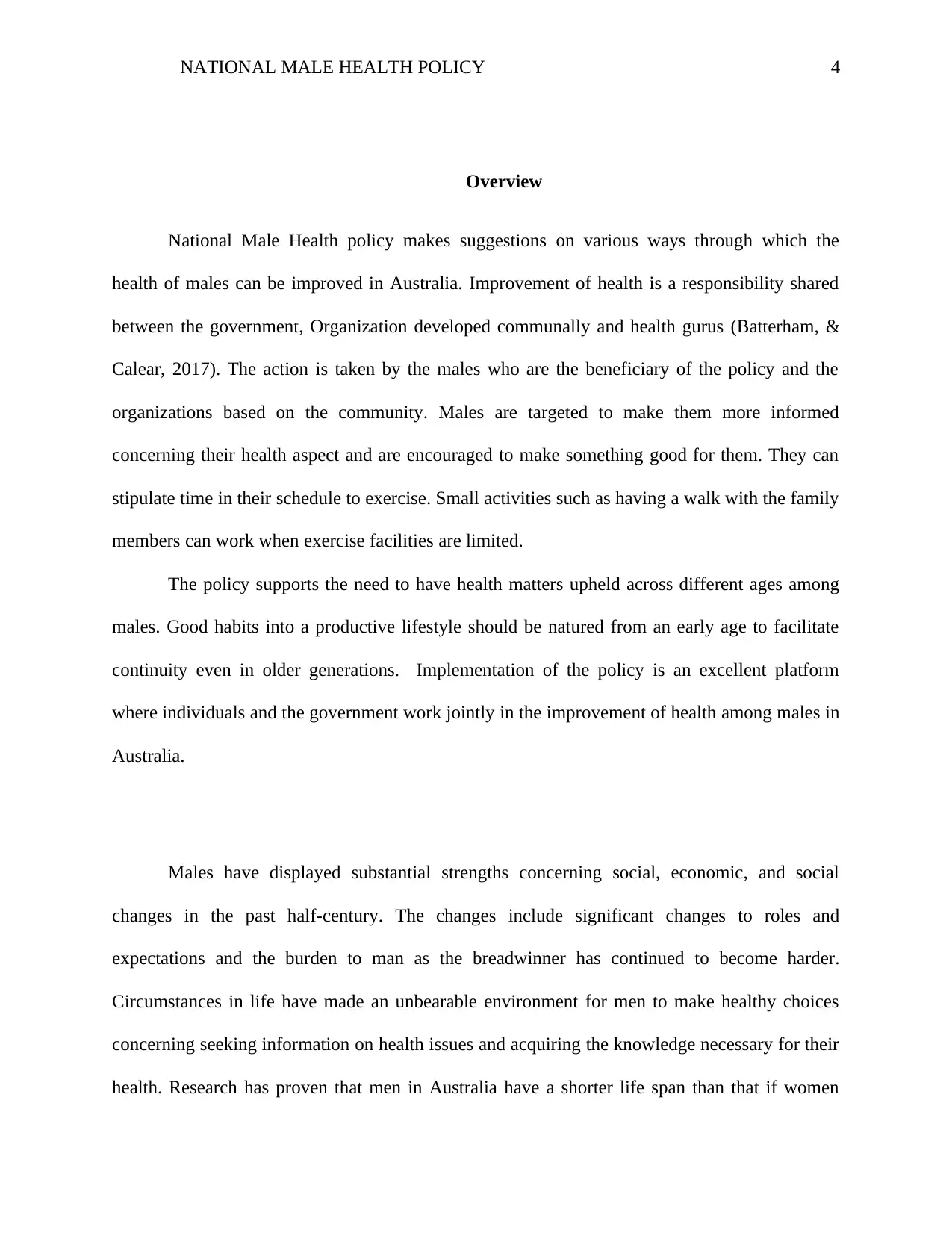
NATIONAL MALE HEALTH POLICY 4
Overview
National Male Health policy makes suggestions on various ways through which the
health of males can be improved in Australia. Improvement of health is a responsibility shared
between the government, Organization developed communally and health gurus (Batterham, &
Calear, 2017). The action is taken by the males who are the beneficiary of the policy and the
organizations based on the community. Males are targeted to make them more informed
concerning their health aspect and are encouraged to make something good for them. They can
stipulate time in their schedule to exercise. Small activities such as having a walk with the family
members can work when exercise facilities are limited.
The policy supports the need to have health matters upheld across different ages among
males. Good habits into a productive lifestyle should be natured from an early age to facilitate
continuity even in older generations. Implementation of the policy is an excellent platform
where individuals and the government work jointly in the improvement of health among males in
Australia.
Males have displayed substantial strengths concerning social, economic, and social
changes in the past half-century. The changes include significant changes to roles and
expectations and the burden to man as the breadwinner has continued to become harder.
Circumstances in life have made an unbearable environment for men to make healthy choices
concerning seeking information on health issues and acquiring the knowledge necessary for their
health. Research has proven that men in Australia have a shorter life span than that if women
Overview
National Male Health policy makes suggestions on various ways through which the
health of males can be improved in Australia. Improvement of health is a responsibility shared
between the government, Organization developed communally and health gurus (Batterham, &
Calear, 2017). The action is taken by the males who are the beneficiary of the policy and the
organizations based on the community. Males are targeted to make them more informed
concerning their health aspect and are encouraged to make something good for them. They can
stipulate time in their schedule to exercise. Small activities such as having a walk with the family
members can work when exercise facilities are limited.
The policy supports the need to have health matters upheld across different ages among
males. Good habits into a productive lifestyle should be natured from an early age to facilitate
continuity even in older generations. Implementation of the policy is an excellent platform
where individuals and the government work jointly in the improvement of health among males in
Australia.
Males have displayed substantial strengths concerning social, economic, and social
changes in the past half-century. The changes include significant changes to roles and
expectations and the burden to man as the breadwinner has continued to become harder.
Circumstances in life have made an unbearable environment for men to make healthy choices
concerning seeking information on health issues and acquiring the knowledge necessary for their
health. Research has proven that men in Australia have a shorter life span than that if women
Paraphrase This Document
Need a fresh take? Get an instant paraphrase of this document with our AI Paraphraser

NATIONAL MALE HEALTH POLICY 5
who have a life expectancy of eighty-three years as compared to that of than that ranges at
seventy-eight years. To address these issues affecting men, the government decided to come up
with a low and National Male Health Policy was developed
The health needs of men across Australia had to be addressed to control the damage
caused on the men due to social responsibilities and also to support the economy through the
reduction of health complications on males (Rickwood, Webb, Kennedy, & Telford, 2016). To
achieve this, policy advocates for action in multiple fronts by recognizing the needs to engage
males on issues concerning their health. The concerns raised were to improve resources targeting
male health, focus male in dire health outcomes, and also to reduce the barriers associated with
acquiring health care for males. Men are encouraged to learn more about their health, develop a
habit of adopting healthy life routines, and uphold regular checkups and to seek medical
attention when necessary.
Aims of the Policy
The most crucial objective of the plan is to improve the health levels among the males
and to provide medical attention to those exposed to poor health. Six priority areas were
developed in the aim of achieving equal health outcomes (Rickwood, Webb, Kennedy, &
Telford, 2016). The outcomes are to promote the best health outcome, equality between different
groups, health improvement at different ages, prevention, better health care services for men, and
coming up with a piece of substantial evidence on health.
Health Outcomes
To achieve this aim, the policy advocates that services development should aim similar
results in health concerning the males and the females. Biological needs between the males and
who have a life expectancy of eighty-three years as compared to that of than that ranges at
seventy-eight years. To address these issues affecting men, the government decided to come up
with a low and National Male Health Policy was developed
The health needs of men across Australia had to be addressed to control the damage
caused on the men due to social responsibilities and also to support the economy through the
reduction of health complications on males (Rickwood, Webb, Kennedy, & Telford, 2016). To
achieve this, policy advocates for action in multiple fronts by recognizing the needs to engage
males on issues concerning their health. The concerns raised were to improve resources targeting
male health, focus male in dire health outcomes, and also to reduce the barriers associated with
acquiring health care for males. Men are encouraged to learn more about their health, develop a
habit of adopting healthy life routines, and uphold regular checkups and to seek medical
attention when necessary.
Aims of the Policy
The most crucial objective of the plan is to improve the health levels among the males
and to provide medical attention to those exposed to poor health. Six priority areas were
developed in the aim of achieving equal health outcomes (Rickwood, Webb, Kennedy, &
Telford, 2016). The outcomes are to promote the best health outcome, equality between different
groups, health improvement at different ages, prevention, better health care services for men, and
coming up with a piece of substantial evidence on health.
Health Outcomes
To achieve this aim, the policy advocates that services development should aim similar
results in health concerning the males and the females. Biological needs between the males and
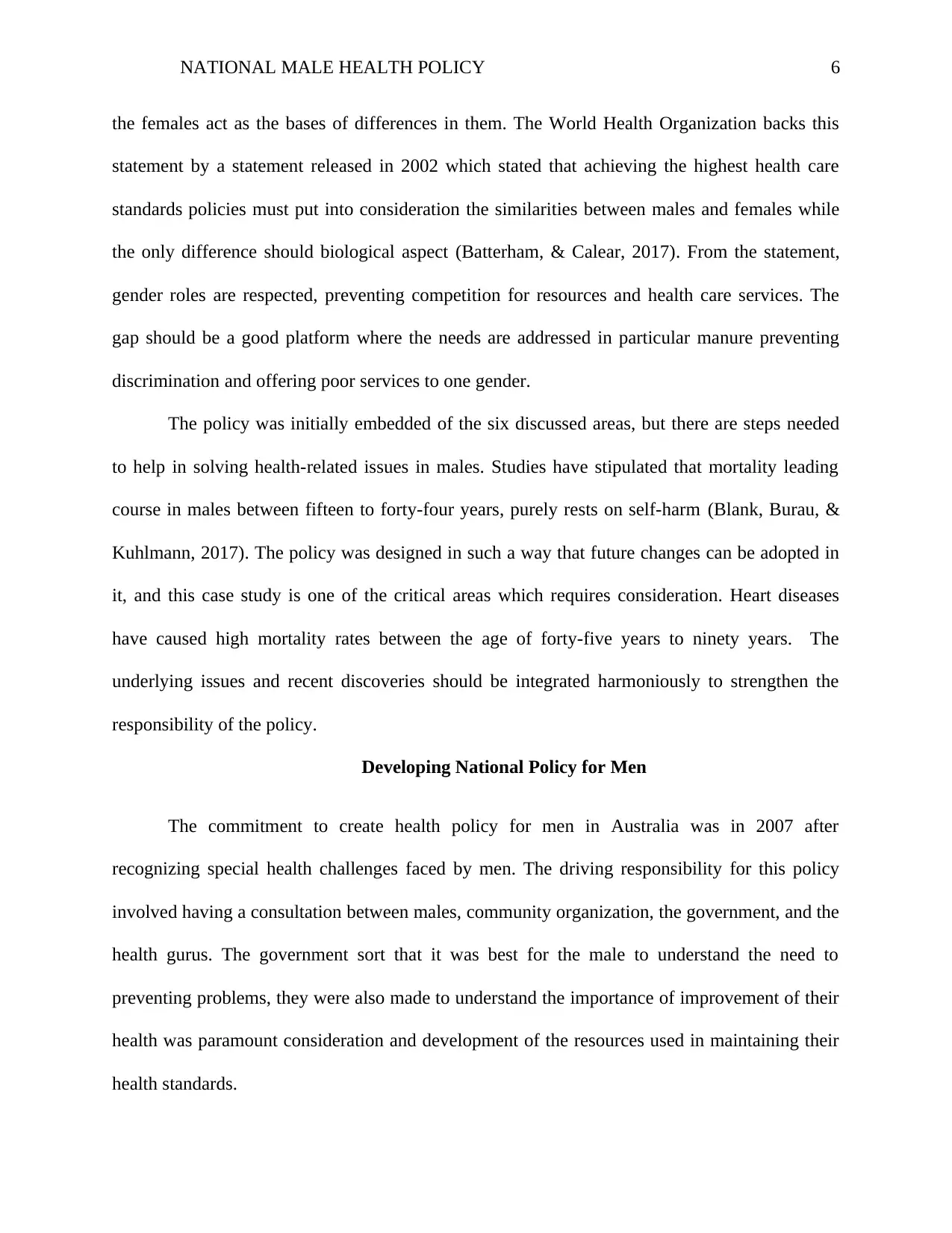
NATIONAL MALE HEALTH POLICY 6
the females act as the bases of differences in them. The World Health Organization backs this
statement by a statement released in 2002 which stated that achieving the highest health care
standards policies must put into consideration the similarities between males and females while
the only difference should biological aspect (Batterham, & Calear, 2017). From the statement,
gender roles are respected, preventing competition for resources and health care services. The
gap should be a good platform where the needs are addressed in particular manure preventing
discrimination and offering poor services to one gender.
The policy was initially embedded of the six discussed areas, but there are steps needed
to help in solving health-related issues in males. Studies have stipulated that mortality leading
course in males between fifteen to forty-four years, purely rests on self-harm (Blank, Burau, &
Kuhlmann, 2017). The policy was designed in such a way that future changes can be adopted in
it, and this case study is one of the critical areas which requires consideration. Heart diseases
have caused high mortality rates between the age of forty-five years to ninety years. The
underlying issues and recent discoveries should be integrated harmoniously to strengthen the
responsibility of the policy.
Developing National Policy for Men
The commitment to create health policy for men in Australia was in 2007 after
recognizing special health challenges faced by men. The driving responsibility for this policy
involved having a consultation between males, community organization, the government, and the
health gurus. The government sort that it was best for the male to understand the need to
preventing problems, they were also made to understand the importance of improvement of their
health was paramount consideration and development of the resources used in maintaining their
health standards.
the females act as the bases of differences in them. The World Health Organization backs this
statement by a statement released in 2002 which stated that achieving the highest health care
standards policies must put into consideration the similarities between males and females while
the only difference should biological aspect (Batterham, & Calear, 2017). From the statement,
gender roles are respected, preventing competition for resources and health care services. The
gap should be a good platform where the needs are addressed in particular manure preventing
discrimination and offering poor services to one gender.
The policy was initially embedded of the six discussed areas, but there are steps needed
to help in solving health-related issues in males. Studies have stipulated that mortality leading
course in males between fifteen to forty-four years, purely rests on self-harm (Blank, Burau, &
Kuhlmann, 2017). The policy was designed in such a way that future changes can be adopted in
it, and this case study is one of the critical areas which requires consideration. Heart diseases
have caused high mortality rates between the age of forty-five years to ninety years. The
underlying issues and recent discoveries should be integrated harmoniously to strengthen the
responsibility of the policy.
Developing National Policy for Men
The commitment to create health policy for men in Australia was in 2007 after
recognizing special health challenges faced by men. The driving responsibility for this policy
involved having a consultation between males, community organization, the government, and the
health gurus. The government sort that it was best for the male to understand the need to
preventing problems, they were also made to understand the importance of improvement of their
health was paramount consideration and development of the resources used in maintaining their
health standards.
⊘ This is a preview!⊘
Do you want full access?
Subscribe today to unlock all pages.

Trusted by 1+ million students worldwide
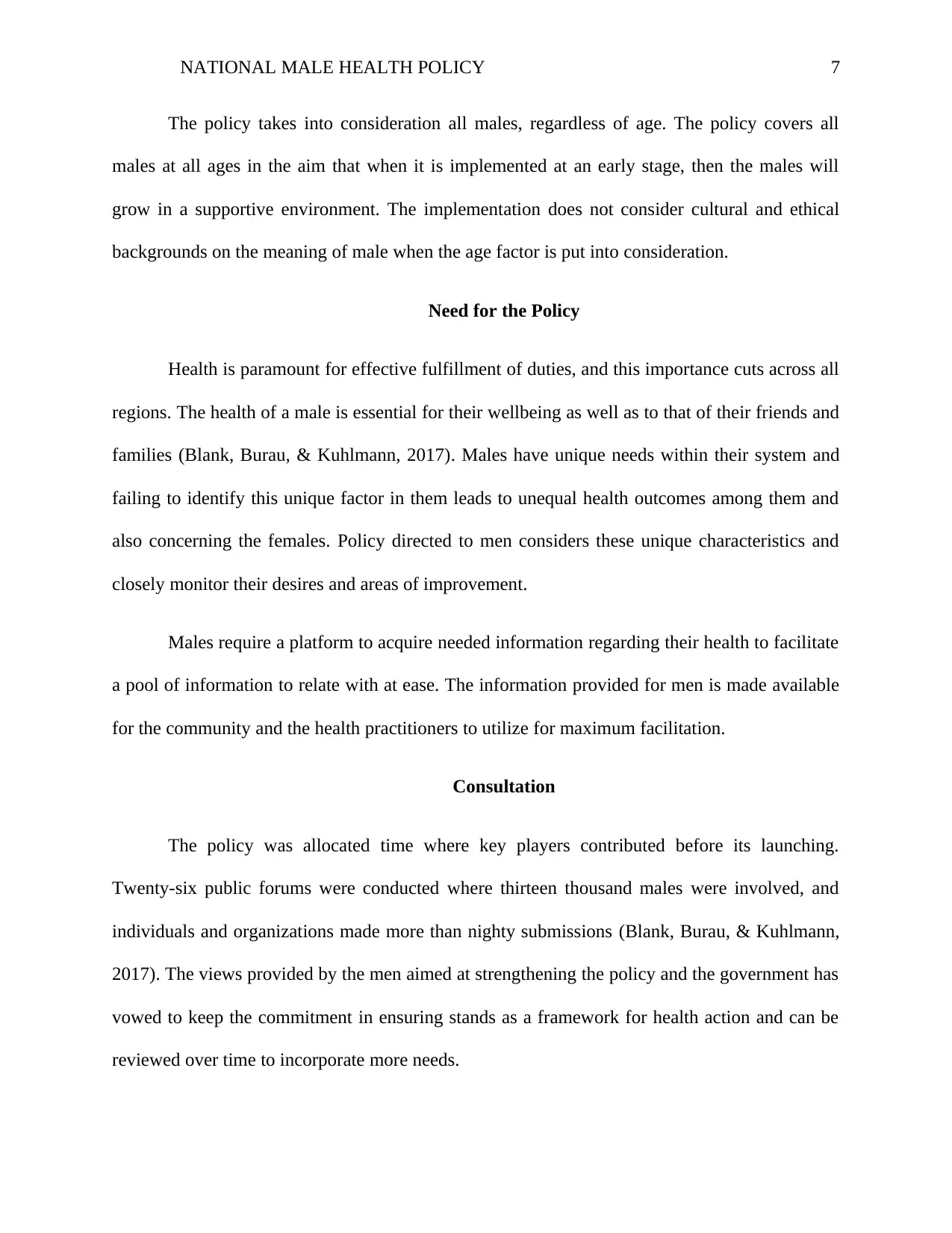
NATIONAL MALE HEALTH POLICY 7
The policy takes into consideration all males, regardless of age. The policy covers all
males at all ages in the aim that when it is implemented at an early stage, then the males will
grow in a supportive environment. The implementation does not consider cultural and ethical
backgrounds on the meaning of male when the age factor is put into consideration.
Need for the Policy
Health is paramount for effective fulfillment of duties, and this importance cuts across all
regions. The health of a male is essential for their wellbeing as well as to that of their friends and
families (Blank, Burau, & Kuhlmann, 2017). Males have unique needs within their system and
failing to identify this unique factor in them leads to unequal health outcomes among them and
also concerning the females. Policy directed to men considers these unique characteristics and
closely monitor their desires and areas of improvement.
Males require a platform to acquire needed information regarding their health to facilitate
a pool of information to relate with at ease. The information provided for men is made available
for the community and the health practitioners to utilize for maximum facilitation.
Consultation
The policy was allocated time where key players contributed before its launching.
Twenty-six public forums were conducted where thirteen thousand males were involved, and
individuals and organizations made more than nighty submissions (Blank, Burau, & Kuhlmann,
2017). The views provided by the men aimed at strengthening the policy and the government has
vowed to keep the commitment in ensuring stands as a framework for health action and can be
reviewed over time to incorporate more needs.
The policy takes into consideration all males, regardless of age. The policy covers all
males at all ages in the aim that when it is implemented at an early stage, then the males will
grow in a supportive environment. The implementation does not consider cultural and ethical
backgrounds on the meaning of male when the age factor is put into consideration.
Need for the Policy
Health is paramount for effective fulfillment of duties, and this importance cuts across all
regions. The health of a male is essential for their wellbeing as well as to that of their friends and
families (Blank, Burau, & Kuhlmann, 2017). Males have unique needs within their system and
failing to identify this unique factor in them leads to unequal health outcomes among them and
also concerning the females. Policy directed to men considers these unique characteristics and
closely monitor their desires and areas of improvement.
Males require a platform to acquire needed information regarding their health to facilitate
a pool of information to relate with at ease. The information provided for men is made available
for the community and the health practitioners to utilize for maximum facilitation.
Consultation
The policy was allocated time where key players contributed before its launching.
Twenty-six public forums were conducted where thirteen thousand males were involved, and
individuals and organizations made more than nighty submissions (Blank, Burau, & Kuhlmann,
2017). The views provided by the men aimed at strengthening the policy and the government has
vowed to keep the commitment in ensuring stands as a framework for health action and can be
reviewed over time to incorporate more needs.
Paraphrase This Document
Need a fresh take? Get an instant paraphrase of this document with our AI Paraphraser
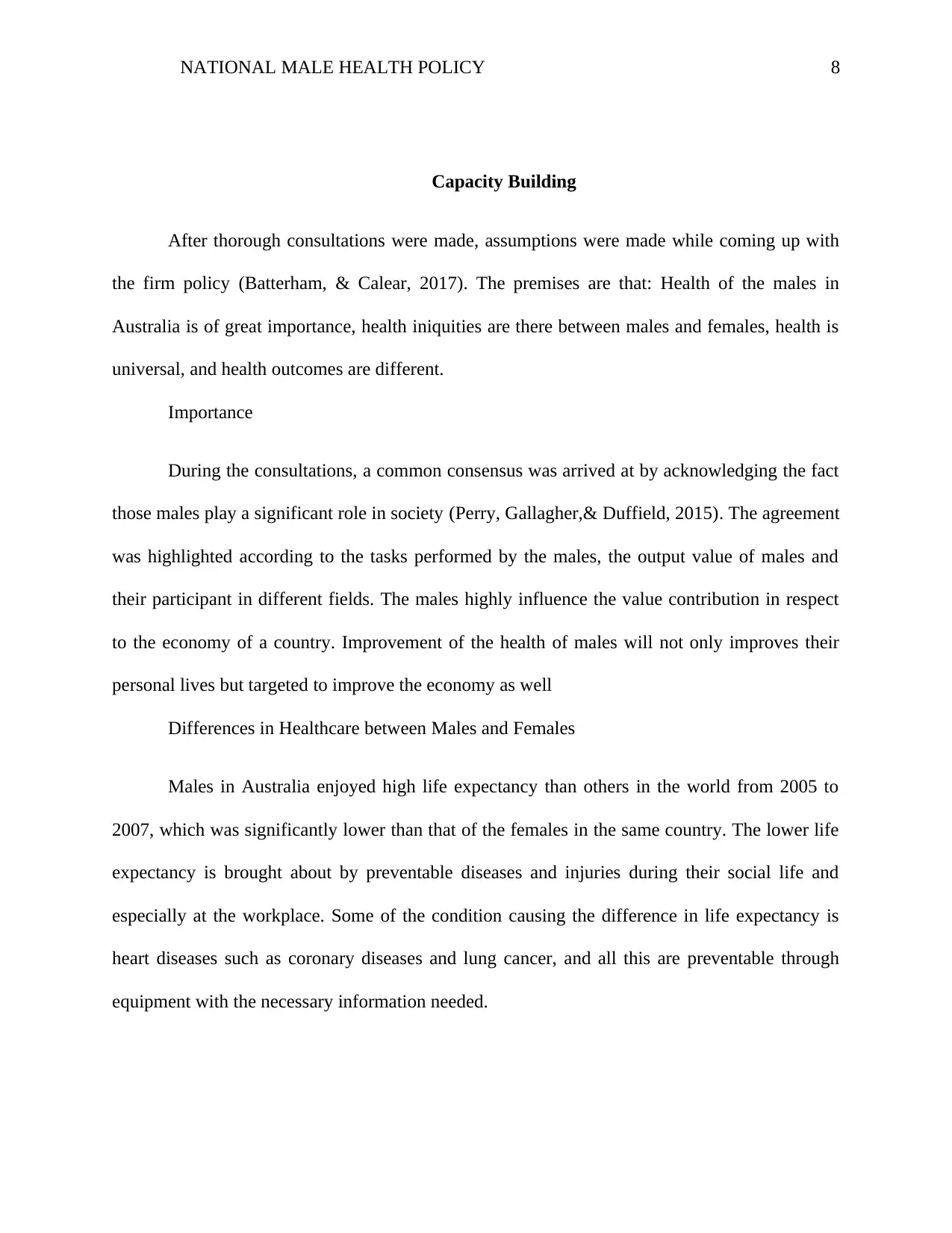
NATIONAL MALE HEALTH POLICY 8
Capacity Building
After thorough consultations were made, assumptions were made while coming up with
the firm policy (Batterham, & Calear, 2017). The premises are that: Health of the males in
Australia is of great importance, health iniquities are there between males and females, health is
universal, and health outcomes are different.
Importance
During the consultations, a common consensus was arrived at by acknowledging the fact
those males play a significant role in society (Perry, Gallagher,& Duffield, 2015). The agreement
was highlighted according to the tasks performed by the males, the output value of males and
their participant in different fields. The males highly influence the value contribution in respect
to the economy of a country. Improvement of the health of males will not only improves their
personal lives but targeted to improve the economy as well
Differences in Healthcare between Males and Females
Males in Australia enjoyed high life expectancy than others in the world from 2005 to
2007, which was significantly lower than that of the females in the same country. The lower life
expectancy is brought about by preventable diseases and injuries during their social life and
especially at the workplace. Some of the condition causing the difference in life expectancy is
heart diseases such as coronary diseases and lung cancer, and all this are preventable through
equipment with the necessary information needed.
Capacity Building
After thorough consultations were made, assumptions were made while coming up with
the firm policy (Batterham, & Calear, 2017). The premises are that: Health of the males in
Australia is of great importance, health iniquities are there between males and females, health is
universal, and health outcomes are different.
Importance
During the consultations, a common consensus was arrived at by acknowledging the fact
those males play a significant role in society (Perry, Gallagher,& Duffield, 2015). The agreement
was highlighted according to the tasks performed by the males, the output value of males and
their participant in different fields. The males highly influence the value contribution in respect
to the economy of a country. Improvement of the health of males will not only improves their
personal lives but targeted to improve the economy as well
Differences in Healthcare between Males and Females
Males in Australia enjoyed high life expectancy than others in the world from 2005 to
2007, which was significantly lower than that of the females in the same country. The lower life
expectancy is brought about by preventable diseases and injuries during their social life and
especially at the workplace. Some of the condition causing the difference in life expectancy is
heart diseases such as coronary diseases and lung cancer, and all this are preventable through
equipment with the necessary information needed.

NATIONAL MALE HEALTH POLICY 9
Health Variance in Males
Australia experiences an odd but at the same time, unique life expectancy among males
in different areas. Males in Torres Strait and Aboriginal experience a worse life expectancy than
those living in other areas. It is also important to note that indigenous males experience a shorter
life span than the non-indigenous (Cooke, & Bartram, 2015). Links to biology, exposure to
knowledge, and social circumstances are some of the factors leading to the differences in life
expectancy among the males.
Economic Factor
The policy acknowledged that men are the driving force in the economy of a country. To
address issues with poverty the health care should be enhanced to encourage a productive nation.
The policy targeted those in rural areas with a high poverty index and with little knowledge on
health .Equipping this group with the needed information provides space will have a high
productivity index which in the long run will reduce mortality rate and medical expenses.
Challenges
Political pressures are discouraging the realization of the policy, which is triggered by the
massive investment in technology in health sectors while services offered are meager. Changes
in disease patterns and demography have also affected the policy (Baum, 2016). In Australia,
there is a high cost of errors, which is possibly two billion dollars. The errors experienced have
degenerated during the implementation of the policy limiting the intended purpose. To solve this
massive cost in errors strategies should be directed towards implementing the new agency for
safety and quality.
Health Variance in Males
Australia experiences an odd but at the same time, unique life expectancy among males
in different areas. Males in Torres Strait and Aboriginal experience a worse life expectancy than
those living in other areas. It is also important to note that indigenous males experience a shorter
life span than the non-indigenous (Cooke, & Bartram, 2015). Links to biology, exposure to
knowledge, and social circumstances are some of the factors leading to the differences in life
expectancy among the males.
Economic Factor
The policy acknowledged that men are the driving force in the economy of a country. To
address issues with poverty the health care should be enhanced to encourage a productive nation.
The policy targeted those in rural areas with a high poverty index and with little knowledge on
health .Equipping this group with the needed information provides space will have a high
productivity index which in the long run will reduce mortality rate and medical expenses.
Challenges
Political pressures are discouraging the realization of the policy, which is triggered by the
massive investment in technology in health sectors while services offered are meager. Changes
in disease patterns and demography have also affected the policy (Baum, 2016). In Australia,
there is a high cost of errors, which is possibly two billion dollars. The errors experienced have
degenerated during the implementation of the policy limiting the intended purpose. To solve this
massive cost in errors strategies should be directed towards implementing the new agency for
safety and quality.
⊘ This is a preview!⊘
Do you want full access?
Subscribe today to unlock all pages.

Trusted by 1+ million students worldwide

NATIONAL MALE HEALTH POLICY 10
Conclusion
National Male Health policy was initiated in twenty ten after fifteen tears from when it
was suggested. The period between the time of suggestion and implementation gave enough
space for Australian people to digest the provision of the policy and were also actively involved
in the development where they gave .Health policy should have a common good for all people,
and the World Health Organization suggested that policy developed for one gender should not
discriminate the other.
The policy aims at increasing the life expectancy of the males in Australia by solving the
health issues experienced. Some of this issues discussed are the provision of necessary
information among the males, appreciating the fact that males exhibit differences in respect to
their age bracket which has to be solved, the need to equipping males with health information
and also targeting those with low income.
Health is paramount; the distinct differences between people living in the same area and
exhibiting different characteristic when all conditions are similar is something to look at keenly.
The males and females in Australia exhibit wired characteristics in which the males have a
higher mortality rate than the females. Some of the factors causing this variance have been
attributed to poor living standards in males and also their exposure to critical information
concerning their health. The policy is built on the criteria of capacity building and equipped with
the necessary information (Cooke, & Bartram, 2015). Realization of the plan was after
consultation and contribution by the stakeholders where changes were provided and thus
embarrassed smoothly after introduction. Health policy should be in line with the needs of the
people and should solve the problems faced.
Conclusion
National Male Health policy was initiated in twenty ten after fifteen tears from when it
was suggested. The period between the time of suggestion and implementation gave enough
space for Australian people to digest the provision of the policy and were also actively involved
in the development where they gave .Health policy should have a common good for all people,
and the World Health Organization suggested that policy developed for one gender should not
discriminate the other.
The policy aims at increasing the life expectancy of the males in Australia by solving the
health issues experienced. Some of this issues discussed are the provision of necessary
information among the males, appreciating the fact that males exhibit differences in respect to
their age bracket which has to be solved, the need to equipping males with health information
and also targeting those with low income.
Health is paramount; the distinct differences between people living in the same area and
exhibiting different characteristic when all conditions are similar is something to look at keenly.
The males and females in Australia exhibit wired characteristics in which the males have a
higher mortality rate than the females. Some of the factors causing this variance have been
attributed to poor living standards in males and also their exposure to critical information
concerning their health. The policy is built on the criteria of capacity building and equipped with
the necessary information (Cooke, & Bartram, 2015). Realization of the plan was after
consultation and contribution by the stakeholders where changes were provided and thus
embarrassed smoothly after introduction. Health policy should be in line with the needs of the
people and should solve the problems faced.
Paraphrase This Document
Need a fresh take? Get an instant paraphrase of this document with our AI Paraphraser

NATIONAL MALE HEALTH POLICY 11
Recommendations on the policy should be welcomed to generate a pool of information
needed for the improvement of the plan (Blank, Burau, & Kuhlmann, 2017). Some of the advice
on the study is to equip the proposal with more room where future changes can be addressed and
dealt with comprehensively. Another consideration should be on divarication on scoop where the
health policy targeting the male should provide a full range scope of issues affecting the males.
There are many areas that men require to be facilitated to archiving higher life expectancy as that
of the females. The policy should not solve the problems indented independently from other
health policy. The system should collaborate with policy dealing with mental stability to address
the issues leading to high suicide cases.
Actualization of the guidelines of the policy requires the utilization of state resources
which has not been actualized, for example, using technological advisement to help in the
distribution of information among the males. The affected age group has been identified clearly,
but efforts to solving the crisis are not provided. The policy directly or indirectly affects the
economics of the country positively. From the discussion on the policy it is true to say that the
policy has positive outcome to the males as the first respondents and to the country in general
Recommendations on the policy should be welcomed to generate a pool of information
needed for the improvement of the plan (Blank, Burau, & Kuhlmann, 2017). Some of the advice
on the study is to equip the proposal with more room where future changes can be addressed and
dealt with comprehensively. Another consideration should be on divarication on scoop where the
health policy targeting the male should provide a full range scope of issues affecting the males.
There are many areas that men require to be facilitated to archiving higher life expectancy as that
of the females. The policy should not solve the problems indented independently from other
health policy. The system should collaborate with policy dealing with mental stability to address
the issues leading to high suicide cases.
Actualization of the guidelines of the policy requires the utilization of state resources
which has not been actualized, for example, using technological advisement to help in the
distribution of information among the males. The affected age group has been identified clearly,
but efforts to solving the crisis are not provided. The policy directly or indirectly affects the
economics of the country positively. From the discussion on the policy it is true to say that the
policy has positive outcome to the males as the first respondents and to the country in general

NATIONAL MALE HEALTH POLICY 12
References
Batterham, P. J., & Calear, A. L. (2017). Preferences for internet-based mental health
interventions in an adult online sample: findings from an online community survey. JMIR
mental health, 4(2), e26.
Baum, F. (2016). The new public health (No. Ed. 4). Oxford University Press.
Blank, R., Burau, V., & Kuhlmann, E. (2017). Comparative health policy. Macmillan
International Higher Education.
Blank, R., Burau, V., & Kuhlmann, E. (2017). Comparative health policy. Macmillan
International Higher Education.
Cooke, F. L., & Bartram, T. (2015). Guest editors’ introduction: human resource management in
health care and elderly care: current challenges and toward a research agenda. Human
Resource Management, 54(5), 711-735.
Davey, J., Holden, C. A., & Smith, B. J. (2015). The correlates of chronic disease-related health
literacy and its components among men: a systematic review. BMC Public Health, 15(1),
589.
Perry, L., Gallagher, R., & Duffield, C. (2015). The health and health behaviours of Australian
metropolitan nurses: an exploratory study. BMC nursing, 14(1), 45.
Rickwood, D., Webb, M., Kennedy, V., & Telford, N. (2016). Who are the young people
choosing web-based mental health support? Findings from the implementation of
Australia's national web-based youth mental health service, eheadspace. JMIR mental
health, 3(3), e40.
References
Batterham, P. J., & Calear, A. L. (2017). Preferences for internet-based mental health
interventions in an adult online sample: findings from an online community survey. JMIR
mental health, 4(2), e26.
Baum, F. (2016). The new public health (No. Ed. 4). Oxford University Press.
Blank, R., Burau, V., & Kuhlmann, E. (2017). Comparative health policy. Macmillan
International Higher Education.
Blank, R., Burau, V., & Kuhlmann, E. (2017). Comparative health policy. Macmillan
International Higher Education.
Cooke, F. L., & Bartram, T. (2015). Guest editors’ introduction: human resource management in
health care and elderly care: current challenges and toward a research agenda. Human
Resource Management, 54(5), 711-735.
Davey, J., Holden, C. A., & Smith, B. J. (2015). The correlates of chronic disease-related health
literacy and its components among men: a systematic review. BMC Public Health, 15(1),
589.
Perry, L., Gallagher, R., & Duffield, C. (2015). The health and health behaviours of Australian
metropolitan nurses: an exploratory study. BMC nursing, 14(1), 45.
Rickwood, D., Webb, M., Kennedy, V., & Telford, N. (2016). Who are the young people
choosing web-based mental health support? Findings from the implementation of
Australia's national web-based youth mental health service, eheadspace. JMIR mental
health, 3(3), e40.
⊘ This is a preview!⊘
Do you want full access?
Subscribe today to unlock all pages.

Trusted by 1+ million students worldwide
1 out of 12
Your All-in-One AI-Powered Toolkit for Academic Success.
+13062052269
info@desklib.com
Available 24*7 on WhatsApp / Email
![[object Object]](/_next/static/media/star-bottom.7253800d.svg)
Unlock your academic potential
Copyright © 2020–2025 A2Z Services. All Rights Reserved. Developed and managed by ZUCOL.


